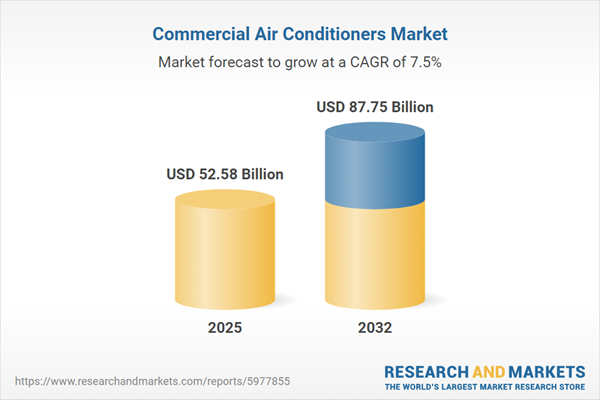Speak directly to the analyst to clarify any post sales queries you may have.
The commercial air conditioners market is undergoing a rapid transformation, propelled by advances in technology, evolving regulations, and the changing demands of modern commercial infrastructure. Senior leaders in the sector require actionable insights to navigate this dynamic landscape and optimize strategic decisions.
Market Snapshot: Commercial Air Conditioners Market Growth & Trends
The commercial air conditioners market grew from USD 49.12 billion in 2024 to USD 52.58 billion in 2025. It is expected to continue growing at a CAGR of 7.52%, reaching USD 87.75 billion by 2032. This growth is driven by increasing urbanization, stricter energy standards, and a global shift toward sustainable cooling solutions. As regulatory pressures mount globally, organizations are streamlining equipment choices to meet corporate sustainability objectives and operational efficiency benchmarks.
Scope & Segmentation of the Commercial Air Conditioners Market
- Product Types: Chillers, ductless systems, packaged air conditioners, split air conditioners, and variable refrigerant flow systems for a spectrum of building applications.
- Components: Air handlers, compressors (rotary and scroll), condensers (air-cooled and water-cooled), duct systems, evaporators, and terminal units, each delivering targeted performance benefits.
- Cooling Capacities: Systems designed to accommodate needs from compact areas to expansive commercial spaces via capacities below 5 tons, 5–15 tons, 16–30 tons, and above 30 tons.
- Refrigerant Types: Options include hydrochlorofluorocarbons and hydrofluorocarbons, with growing momentum toward low-global-warming-potential alternatives.
- Technologies: Inverter and non-inverter air conditioning systems to support performance and energy management goals.
- Installation Types: Solutions suitable for both new installations and retrofit projects within diverse commercial footprints.
- End Users: Educational institutions (schools, universities), healthcare facilities (clinics, hospitals), hospitality venues, office buildings, and a range of retail environments (malls, specialty stores).
- Distribution Channels: Both offline and online procurement platforms, expanding buyer access and option flexibility.
- Regional Coverage: Americas (including North America and Latin America), Europe, Middle East & Africa (EMEA), and Asia-Pacific, each with distinctive regulatory and operational landscapes.
- Key Industry Participants: Notable companies include Airedale International Air Conditioning (Modine), Blue Star Limited, Carrier Global, Daikin Industries, Danfoss, Haier Group, Johnson Controls, Lennox International, Mitsubishi Heavy Industries, Panasonic, Trane Technologies, Whirlpool Corporation, and others.
Key Takeaways for Senior Decision-Makers
- Adoption of advanced controls and digital integration is streamlining maintenance and driving continuous energy and cost optimization for facility managers.
- Growing regulatory and environmental pressures are steering investment toward sustainable refrigerants and high-efficiency systems across regions.
- Market participants are enhancing global service delivery models through strategic partnerships, advanced analytics, and digital monitoring platforms.
- Sophisticated segmentation allows for precise alignment of cooling solutions to diverse commercial environments, with variable refrigerant systems gaining traction where zoning and efficiency matter most.
- The expansion of online procurement and cloud-connected platforms is redefining distribution and after-sale support structures in the sector.
Tariff Impact on Cost Structures and Supply Chain
Recent United States tariffs on key commercial air conditioning components, including compressors and condensers, have created substantial shifts in sourcing and manufacturing strategies. Organizations are exploring supplier diversification and nearshore options, renegotiating contractual terms, and investing in domestic assembly capabilities. These actions are shaping new approaches to inventory control, pricing models, and strategic partnerships, offering paths to mitigate trade-related risk.
Methodology & Data Sources
This report integrates primary interviews with executives and managers across the value chain with an exhaustive review of technical literature, industry journals, and public filings. Quantitative findings were cross-validated with subject matter experts, and case studies illuminated practical applications and best practices. Stringent editorial and peer review ensured insight reliability.
Why This Report Matters
- Benchmark your strategies against evolving technology, regulatory, and sustainability dynamics in the commercial air conditioners market.
- Identify emerging opportunities through clear segmentation and a thorough review of supply chain and tariff influences.
- Enhance planning by leveraging actionable insights into digitalization, innovative contracting, and next-generation system adoption.
Conclusion
The commercial air conditioners market is evolving rapidly as digitalization, sustainability, and regional dynamics reshape priorities. Informed strategies derived from this analysis will support growth, operational efficiency, and compliance in a complex, competitive environment.
Additional Product Information:
- Purchase of this report includes 1 year online access with quarterly updates.
- This report can be updated on request. Please contact our Customer Experience team using the Ask a Question widget on our website.
Table of Contents
3. Executive Summary
4. Market Overview
7. Cumulative Impact of Artificial Intelligence 2025
Companies Mentioned
The companies profiled in this Commercial Air Conditioners market report include:- Airedale International Air Conditioning Ltd. by Modine
- Blue Star Limited
- Carrier Global Corporation
- Cruise Group
- Daikin Industries, Ltd.
- Danfoss A/S
- Electrolux AB
- Haier Group
- Johnson Controls International PLC
- Lennox International Inc.
- LG Electronics Inc.
- Mitsubishi Heavy Industries, Ltd.
- Panasonic Holdings Corporation
- Rheem Manufacturing Company
- Robert Bosch GmbH
- Samsung Electronics Co., Ltd.
- Symphony Limited
- Toshiba Corporation
- Trane Technologies Company, LLC
- Voltas Limited by Tata Group
- Whirlpool Corporation
Table Information
| Report Attribute | Details |
|---|---|
| No. of Pages | 194 |
| Published | November 2025 |
| Forecast Period | 2025 - 2032 |
| Estimated Market Value ( USD | $ 52.58 Billion |
| Forecasted Market Value ( USD | $ 87.75 Billion |
| Compound Annual Growth Rate | 7.5% |
| Regions Covered | Global |
| No. of Companies Mentioned | 22 |









